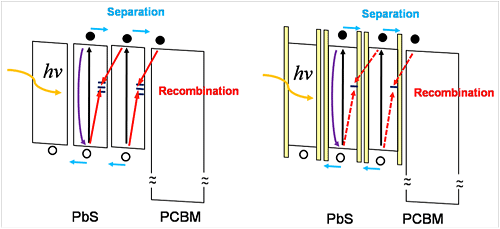Colloidal PbS Quantum Dots Solar Cells with High Fill Factor
We fabricate PbS colloidal quantum-dot (QD)-based solar cells using a fullerene derivative as the electron transporting layer (ETL). A thiol treatment and oxidation process are used to modify the morphology and electronic structure of the QD films, resulting in devices that exhibit an open-circuit voltage (VOC) of 0.47 V and a fill factor (FF) of 62%. These values are the highest among published VOC and FF for PbS and PbSe-QD-based solar cells to date. The power-conversion efficiency reaches 1.3% under 1-sun AM1.5 test conditions and 2.4% under monochromatic infrared (λ = 1310 nm) illumination. A consistent mechanism for device operation is developed through a circuit model and experimental measurements, shedding light on new approaches to the optimization of solar-cell performance by engineering the interface between the QDs and the neighboring charge-transport layers.

Figure 1: Illustration of the charge-flow mechanism in the pristine (left) and air-annealed (right) PbS QD/PCBM devices. The black arrows denote the exciton generation process, the purple arrows denote the geminate electron-hole pair recombination process, the blue arrows denote the charge separation process, and the red arrows denote the bimolecular recombination process (assisted by midgap states). The thin wider band gap layers (yellow) that surround each QD in the right figure represent the oxide compounds, and the dashed red arrows indicate a suppressed charge recombination via the bimolecular process.